Standard [CURRENT]
ASTM E 1928:2025
Standard Test Method for Estimating the Approximate Residual Circumferential Stress in Straight Thin-walled Tubing
- Publication date
- 2025
- Original language
- English
- Pages
- 4
- Publication date
- 2025
- Original language
- English
- Pages
- 4
- DOI
- https://dx.doi.org/10.1520/E1928-25
Product information on this site:
Quick delivery via download or delivery service
Buy securely with a credit card or pay upon receipt of invoice
All transactions are encrypted
Short description
1.1 This test method provides a qualitative estimate of the residual circumferential stress at the surface of thin-walled metallic tubing. It can also be used to estimate the residual stresses that remain in tubing after removal from service, subject to different environments or operating conditions. The residual stress estimate is determined from the change in outside diameter that occurs upon splitting a length of the tubing. The computational method approximates the stress distribution through the tubing wall thickness as being linear; it does not provide any details of local stress features such as surface stress gradients. The method is applicable for estimating residual stresses up to the material yield stress. 1.2 Units- The values stated in SI units are to be regarded as standard. The values given in parentheses after SI units are provided for information only and are not considered standard. 1.3 This standard does not purport to address all of the safety concerns, if any, associated with its use. It is the responsibility of the user of this standard to establish appropriate safety, health, and environmental practices and determine the applicability of regulatory limitations prior to use. 1.4 This international standard was developed in accordance with internationally recognized principles on standardization established in the Decision on Principles for the Development of International Standards, Guides and Recommendations issued by the World Trade Organization Technical Barriers to Trade (TBT) Committee.
ICS
23.040.10,
23.040.15
DOI
https://dx.doi.org/10.1520/E1928-25
Also available in
Loading recommended items...
Loading recommended items...
Loading recommended items...

